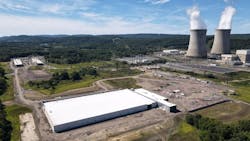Data Center Nuclear Power Update: Microsoft, Constellation, AWS, Talen, Meta
Five weeks ago we reported on the power purchase agreement signed by Microsoft that would have the new owners of the Three Mile Island (TMI) nuclear generating station restarting Unit 1 of the power plant, which had been shut down in 2019.
Highlighting the urgency of the hyperscaler’s needs, the new owners of the facility, Constellation, have already had their first open hearing with the Nuclear Regulatory Commission (NRC) where they have proposed a three year timeline to commercial operation. Restarting the plant would be necessary for Constellation to meet the demands of the Microsoft PPA.
When Unit 1 of the TMI plant was shut down in 2019, it had more than a decade remaining on the NRC-granted license and was shut down due to a lack of economic viability, not due to any technical issues. Unit 1 was not involved in the infamous accident on March 28, 1979 that caused the closure of Unit 2 of the TMI site, with the unit damaged beyond repair.
At last week’s hearing, Constellation confirmed that they would be renaming the plant the Crane Clean Energy Center, which is one of the items that requires approval from the NRC.
Many Voices To Be Heard
Unsurprisingly, anti-nuclear activist groups are already making their voices heard, led by the group Three Mile Island Alert.
Initially their message was that the marketplace had decided that nuclear was unnecessary, but with the massive increase in demand for power that is currently ongoing, their primary message now seems to be addressing safety and security issues, along with storage of nuclear waste and the perception that the average rate payer will be paying for the restart and upgrades to the plant.
While public perception is an issue that Constellation will need to constantly address, especially with the reaction that the local area has to mention of the TMI accident, all of the technical concerns that the watchdog groups are raising are required by the NRC to be addressed in the planning and approval stages of the application to restart the plant.
The total cost to restart the facility has not been disclosed, but Constellation has applied for a $1.6 billion loan from the Department of Energy to fund the restart. Holtec International, who is working on restarting the Palisades Nuclear Plant in Michigan, was recently approved by the DOE for a $1.52 billion loan for similar purposes.
With the three year timeline for plant restoration, Constellation has already started restoring and replacing equipment at the site. According to Plant Manager Trevor Orth, there were no major issues found with the equipment on site during chemical cleaning and pressure-testing that was done earlier in 2024.
Quoted by the local NPR affiliate, Orth said, ““I’m not saying there is no work to do, but it was kind of like a typical outage.” Outages are a standard part of the process at nuclear power plants and are scheduled plant shutdowns where the reactors are refueled, and site maintenance is performed.
Local Economic Impact and Development Timeline
At the hearing, it was disclosed that there are currently 100 former TMI employees already at work on the site, an indication of the number of employees required to keep the plant running. Constellation already has some 200 job opening posted for the facility with a three year staffing target of more than 700 positions.
While all of the timelines that Constellation talked about are subject to ongoing approval from the NRC, the expectation is that it will take no less than two years for the review and approval of a new operating license to be granted, which would allow commercial power generation to begin in 2028 on a 20-year license.
The company has a fairly aggressive timeline they want to adhere to for returning to full operation; though, keep in mind that the NRC has stated that they will be holding additional public meetings in the Harrisburg, PA area to get further community input. At any point, the NRC could delay any future progress on the project.
Here's Constellation's timeline for reopening the TMI nuclear plant:
- Before June 2025: Restore simulator for training.
- November 2024: Submit Restoration Quality Assurance Plan to NRC (a document that describes the steps necessary to restart the plant).
- November 2024: Apply for an exemption from restrictions that prohibit operation of the reactor and placement of fuel into the reactor vessel. An agreement is in place that the reactor would not be restarted making this the key approval required from the NRC.
- December 2024: Submit steam generator report (the current state of the power generation equipment).
- February 2025: Submit request for the name change from Three Mile Island to Crane Clean Energy Center.
- March 2025: Submit updated report on the decommissioning status and how fuel will be managed.
- April through June 2025: Apply to rescind exemptions granted due to decommissioning status. Begin training new operators.
- July 2025: Submit required environmental impact report, operating license and technical specifications amendments, and a preliminary final safety analysis.
- September. 2025: Submit revised emergency plan.
- November. 2025: Submit revised physical security plan.
- Second quarter 2027: Self-assessment of plant performed by Constellation
- July 2027: Submit operational readiness letter.
- By August 2027 Constellation would expect both the NRC and FEMA to have completed their evaluation of the submitted emergency plans required for an operational reactor site.
- By the end of 2027, the company expects to have received the new operating license.
- 2028 – return to commercial power generation.
It should be noted that although Constellation does have work in process at the TMI site, the plant is still officially in the decommissioning stage.
Funding for this stage comes from a trust fund that all nuclear power plants have that must be funded to support the decommisioning and cleanup of the facility once it is finishes its opeational life. None of those funds can be applied to restarting operation of the plant.
Funds for this process must come from Constellation and its partners, be it in the form of loans, grants, or other types of new funding specific to the restart of operations.
Amazon, Talen Attempt to Amend Agreement for Additional Nuclear Power Is Denied
It's not all smooth sailing for hyperscalers looking to add additional nuclear power, even when it doesn't require a new or restarted facility.
On November 1st the Federal Energy Regulatory Commission (FERC) rejected an amendment to the agreement between Amazon and Talen Energy Corporation that we reported on back in March. The goal of the amendment was to expand power sales to the Amazon data center from 300 MW to 480 MW for the collocated data center.
The amendment was filed by PJM Interconnect, the regional transmission organization that is responsible for moving wholesale power in its area of operation. The vote was 2-1 to deny the amendment, with the two other FERC members not in attendance at the meeting.
The members voting against the amendment did so as they had determined that the amended ISA (interconnection service agreement) did not demonstrate that it was necessary to contravene the existing agreement, or identify any unique factors that would require the change.
Talen is considering the next steps it should take, and stated:
“On Friday, FERC issued an order denying PJM, PPL, and Talen’s Susquehanna ISA. Talen believes FERC erred and we are evaluating our options, with a focus on commercial solutions. We believe this ISA amendment is just and reasonable and in the best interest of consumers. FERC’s decision will have a chilling effect on economic development in states such as Pennsylvania, Ohio, and New Jersey.”
Meta's Data Center Nuclear Energy Push Scuttled By Rare Bees
Finally, as reported last week by Financial Times, Mark Zuckerberg’s initial plans for Meta to build an AI data center powered by nuclear energy in the U.S. were scuttled, partly due to the discovery of a rare bee species on the proposed site, according to sources.
Meta is hoping to partner with a nuclear plant operator for emissions-free power to support ongoing AI demand according to its net zero ambitions. However, the proposed project's environmental and regulatory setbacks, including the bee discovery, would complicate construction, Zuckerberg reportedly said at a recent Meta all-hands meeting.
In the meeting, Zuckerberg, in seeking to prove the viability of Meta’s AI investments, reportedly expressed frustration over the U.S.’s deliberate nuclear energy progress, especially compared to China’s rapid reactor expansion. Meta, which has been net-zero since 2020, declined to comment.
As major hyperscaler competitors like Amazon, Google, and Microsoft secure nuclear power deals to meet rising energy demands for AI, Meta's hunt for carbon-free energy options, including nuclear, is only to be expected. In recent months, as noted above, Microsoft revived the Three Mile Island nuclear plant, Amazon invested $650 million in a data center next to Pennsylvania's Susquehanna nuclear plant, and Google has ordered small modular reactors from U.S. startup Kairos Power.
In wake of the rare bees report, Popular Science offered some speculation regarding the possible bee species and on the site of the undisclosed nuclear power plant whereat Meta features building its AI data center.
California’s lone operational nuclear facility is at the moment Diablo Canyon Power Plant in San Luis Obispo County. Given that the bureaucracy for approving and constructing any new nuclear plant takes years to wrangle, it’s possible Meta wants to court Diablo Canyon’s owners at PG&E to keep up with AI competition among the hyperscale giants. Diablo Canyon representatives reportedly did not respond to Popular Science's inquiries.
Meanwhile, Purdue University assistant professor of entomology Brock Harpur told Popular Science he believes that the current status of U.S. bee species points to a few clues. “If it’s in California, there are now several protected bumble bees,” Harpur told Popular Science.
Per data from WRA Environmental Consultants, the Crotch bumblebee (Bombus crotchii), Franklin's bumblebee (B. franklini), western bumblebee (B. occidentalis), and Suckley's cuckoo bumblebee (B. suckleyi) are now the first insects to be protected under the California Endangered Species Act (CESA), although some aquatic invertebrates are already protected.

David Chernicoff

Matt Vincent
A B2B technology journalist and editor with more than two decades of experience, Matt Vincent is Editor in Chief of Data Center Frontier.






